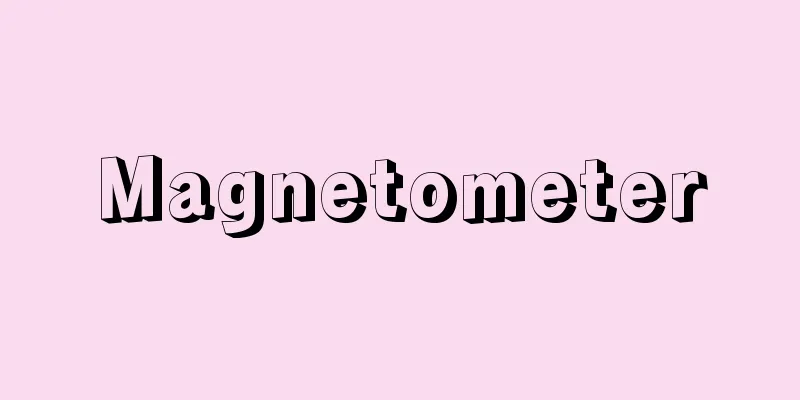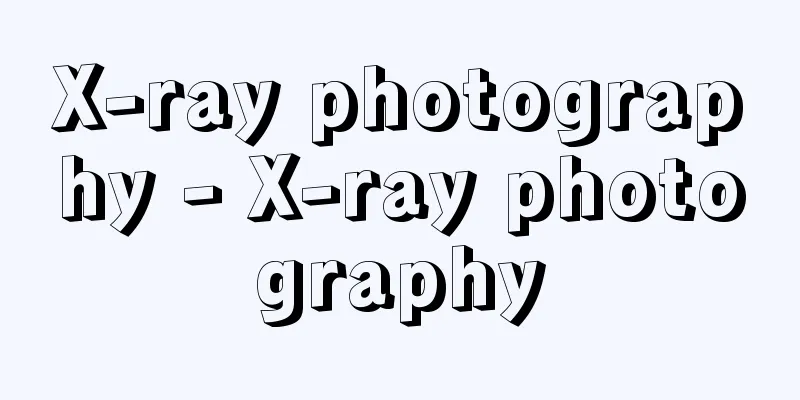Magnetometer

|
A general term for magnetization measuring devices that measure the magnetic strength (= magnetization) of materials, and magnetic field measuring devices that measure magnetic fields. (1) Magnetization measuring devices These are roughly divided into two types according to the measurement principle. The first type applies Faraday's law of electromagnetic induction. When a sample placed in the center of a pair of search coils is moved, an electromotive force is generated in the coil. This electromotive force is proportional to the time change of the magnetic flux in the coil, so by moving the sample at the same speed and comparing it with the electromotive force of a standard sample, the total magnetic moment (μ) of the sample (hence, the magnetic moment per unit volume = magnetization M ) can be known. A method of mechanically vibrating the sample is called a sample vibration type magnetometer, and is widely used ( ). The second principle utilizes the force that a magnetic material receives from an inhomogeneous magnetic field. The sample is placed a little away (perpendicular to the magnetic field) from the center between the opposing N and S poles of an electromagnet. Paramagnetic or ferromagnetic materials are subjected to an attractive force toward the center of the magnetic poles (the position of the maximum magnetic field) (the force is in the opposite direction for diamagnetic materials). This force is proportional to the total magnetic moment (μ) of the sample, so μ can be calculated by measuring the magnitude and direction of the force. A highly sensitive balance is often used to measure force. In this case, the position of the sample is shifted vertically upward from the center of the magnetic pole. This method is called a magnetic balance ( ). Methods that utilize force were the mainstream for magnetization measurements from the time of Pierre Curie (Marie Curie's husband) (the late 19th century) until the 1960s and 1970s, but from the late 1970s onwards, sample vibration type magnetometers became mainstream. (2) Magnetic field measuring devices There are various measuring principles, and they are used according to the purpose. The most basic is the one that applies the law of electromagnetic induction mentioned above, and measures the electromotive force generated in a search coil placed in a magnetic field. In the case of a static magnetic field, the coil is moved, and in the case of a magnetic field that changes over time, a stationary coil is used. This method can be applied to all magnetic fields except for very weak magnetic fields. In addition, many devices use the Hall effect of semiconductors, which is convenient for measuring medium magnetic fields. Somewhat more specialized devices use nuclear magnetic resonance (of hydrogen protons in H2O ), the Josephson effect of superconductors, the Faraday effect of light, and magnetoresistance. The nuclear magnetic resonance method is suitable for precise measurement of magnetic fields, while the Josephson effect method is suitable for measuring very small magnetic fields. [Miyadai Asanao] [References] | | |The pair of search coils are connected in reverse. are magnetic field lines that represent the magnetic field . Principle of the vibrating sample magnetometer (Fig. A) The direction of the force ( ) in the case of a paramagnetic or ferromagnetic material. The sample is placed vertically above the central axis of the magnet. The magnetic field lines represent the magnetic field . Principle of magnetic balance (Figure B) Source: Shogakukan Encyclopedia Nipponica About Encyclopedia Nipponica Information | Legend |
|
物質の磁気の強さ(=磁化)を測る磁化測定装置と、磁場を測る磁場測定装置の総称。 (1)磁化測定装置 測定原理により2種に大別される。第一は、ファラデーの電磁誘導の法則を応用するもの。1対のサーチコイルの中央に置かれた試料を動かすとコイルに起電力を発生する。この起電力は、コイル内の磁束の時間変化に比例するので、試料を動かす速さを同じにして、標準試料の場合の起電力と比較することによって、試料の全磁気モーメント(μ)(したがって、単位体積当りの磁気モーメント=磁化M)を知ることができる。試料を機械的に振動させる方式が試料振動型磁力計で、広く使用されている()。第二の原理は、磁性体が不均一な磁場から受ける力を利用するもの。電磁石の向かい合うN、S磁極間中心より(磁場に垂直方向に)少し離れた位置に、試料を置く。常磁性体または強磁性体は磁極中心(最大磁場の位置)に向かう吸引力を受ける(反磁性体では逆向きの力になる)。この力は試料の全磁気モーメント(μ)に比例するので、力の大きさと向きを測れば、μを求められる。力の測定には高感度の天秤(てんびん)を使うことが多い。この場合には、試料の位置は磁極中心から鉛直上方へずらせる。この方式を磁気天秤という()。力を利用する方法は、ピエール・キュリー(マリー・キュリーの夫)の時代(19世紀末)から1960~1970年代ころまで磁化測定の主流をなしていたが、1970年代後半ころから試料振動型の磁力計が主流になってきた。 (2)磁場測定装置 種々の測定原理のものがあり、目的に応じて使い分ける。前述の電磁誘導の法則を応用するものがもっとも基本的で、磁場内に置かれたサーチコイルに発生する起電力を測定する。静磁場の場合はコイルを動かし、時間変化する磁場の場合は静止コイルを用いる。この方式は、ごく微弱な磁場を除いてはすべての磁場に応用できる。そのほかに、半導体のホール効果を利用したものが多く使われ、中程度の磁場測定には便利である。やや特殊なものとして、(H2O内水素の陽子の)核磁気共鳴、超伝導体のジョセフソン効果、光のファラデー効果、磁気抵抗などを応用したものもある。核磁気共鳴の方法は磁場の精密測定に、ジョセフソン効果の方法は微小磁場の測定に適する。 [宮台朝直] [参照項目] | | |1対のサーチコイルは逆接続になっている。は、磁界を表す磁力線である©Shogakukan"> 試料振動型磁力計の原理〔図A〕 常磁性体または強磁性体の場合の力()の方向を示す。試料は―の中心軸の鉛直上方に置く。は、磁界を表す磁力線©Shogakukan"> 磁気天秤の原理〔図B〕 出典 小学館 日本大百科全書(ニッポニカ)日本大百科全書(ニッポニカ)について 情報 | 凡例 |
<<: Magnetic sorting - magnetic sorting
Recommend
IPC (International Organization)
…Japan joined in 1978. (10) IPC Agreement (Strasb...
Yakuno [town] - Yakuno
A former town in Amata County in the central-weste...
Wang Yujyo
…During the An Lushan Rebellion, he unwillingly s...
Regulated verse
One of the styles of classical Chinese poetry. It...
Linear form
A linear mapping from a linear space V over a fiel...
Sutherland, EW
…For this reason, cAMP generally refers to the la...
Setsubun - Setsubun
[1] (meaning the turning point of the seasons)① Th...
Manipulator - manipulator (English spelling)
A remote-controlled machine that is designed to h...
ministerialis
…It is translated as vassal or household member, ...
IBF System - IBF System
...This is a system called the International Bank...
Goldie, G. (English spelling) GoldieG
...a Royal Company that promoted British commerci...
Additive group
Please see the "Abelian groups" page. S...
Ueno-juku
...A town in Aki County, central Mie Prefecture. ...
Notke, B.
...In the second half of the 14th century, the Pa...
Legend of the King's Oak
…The general English name for trees in the Quercu...









